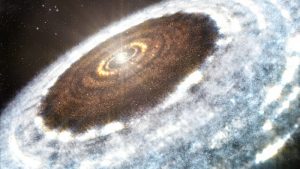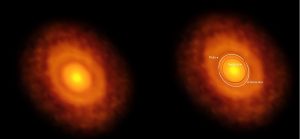
Using data from the Atacama Large Millimetre/submillimeter Array (ALMA) in Chile, astronomers have now, for the first time, made a distinct (resolved) observation of a water snow line in the planet-forming disk around a young star. The water snow line – sometimes called the frost line – is the distance from a young star at which temperatures drop low enough for compounds such as water, ammonia, methane, carbon dioxide, carbon monoxide to condense into solid ice or “snow.” Astronomer Lucas Cieza and his team published these results in the journal Nature on July 14, 2016.
As a new solar system is forming, the thick disk of matter that will eventually create new planets – called a protoplanetary disk by astronomers – orbits around a very young star. Water inside that disk may be gaseous for up to about 3 astronomical units, that is, 3 AU or 3 times the distance between our Earth and sun.
Beyond that distance, as the pressure drops, water will solidify into ice and coat dust particles. The distance from the new stars where this change occurs is called the water snow line, or frost line.
Orion The Hunter is among the brightest and most beautiful constellations seen high in the sky on January and February evenings, and before dawn beginning around late July and early August. It’s in this direction in our sky that the star V883 Orionis is located, the site of this new observation of the water snow line.
V883 Orionis is a special star because matter from its protoplanetary disk fell into the star and had a blinding consequence: an outburst of light such that V883 is 400 times brighter than our sun for only 30% more mass.
This wild increase in its brightness pushed the water snow line to 40 AU, or 40 times the Earth-sun distance and the average distance between our sun and dwarf planet Pluto.

Lucas Cieza from the Universidad Diego Portales, Santiago, Chile, lead author of this study, commented in a statement:
The ALMA observations came as a surprise to us. Our observations were designed to look for disk fragmentation leading to planet formation. We saw none of that; instead, we found what looks like a ring at 40 AU.
Such a fortunate result is important in astronomy, because small rocky planets such as the Earth form within the water snow line.
Read the team’s research paper, published in Nature.
Bottom line: On July 14, 2016, Lucas Cieza and his team made the first distinct observation of a water snow-line – the area in the protoplanetary disc where water turns solid and coats dust – using the Atacama Large Millimetre/submillimeter Array (ALMA) . The observation was possible due to an outburst of star V883 Orionis that pushed out the water snow-line to make it more visible.











